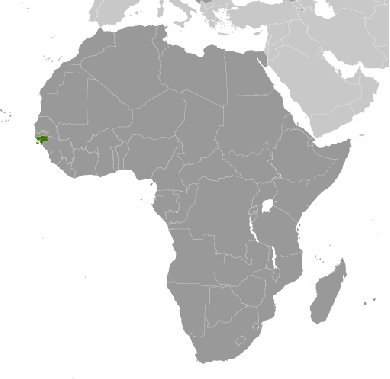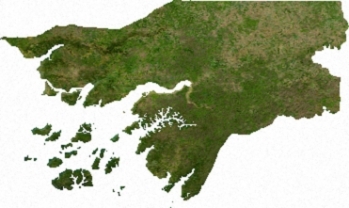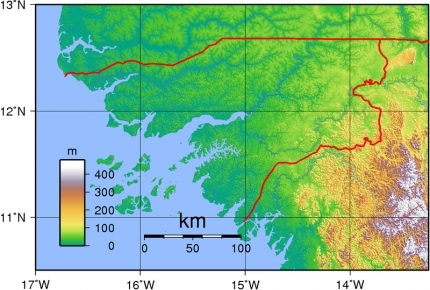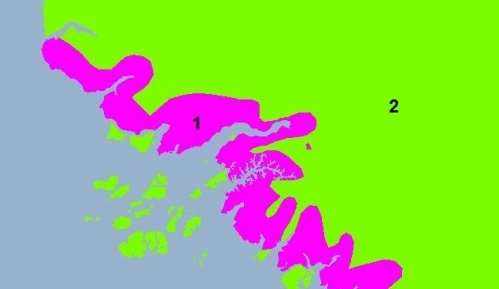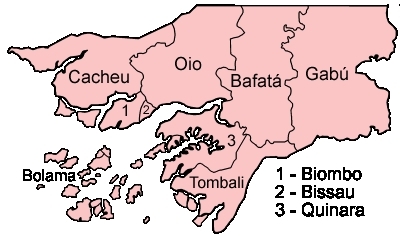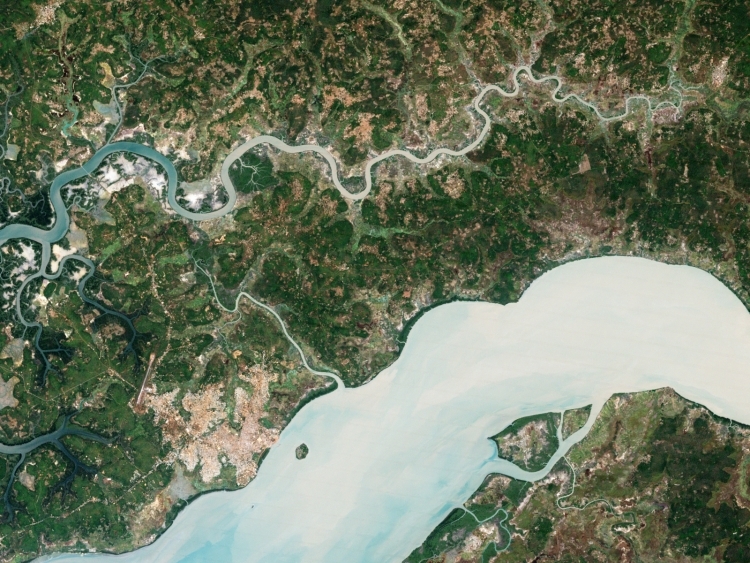Guinea-Bissau
| Topics: |
Countries and Regions of the World Collection  Guine-Bissau is a nation of 1.6 million people in west Africa, bordering the North Atlantic Ocean, between Guinea and Senegal.
Guine-Bissau is a nation of 1.6 million people in west Africa, bordering the North Atlantic Ocean, between Guinea and Senegal.
Guinea-Bissau is a relatively small country which is swampy along its western coast and low-lying inland.
Guinea-Bissau's major environmental issues include:
- deforestation;
- soil erosion;
- overgrazing; and,
- overfishing.
It is susceptible to hot, dry, dusty harmattan haze which can reduce visibility during dry season; and, to brush fires.
The rivers of Guinea and the islands of Cape Verde were among the first areas in Africa explored by the Portuguese in the 15th century. Portugal claimed Portuguese Guinea in 1446, but few trading posts were established before 1600.
In 1630, a "captaincy-general" of Portuguese Guinea was established to administer the territory. With the cooperation of some local tribes, the Portuguese entered the slave trade and exported large numbers of Africans to the Western Hemisphere via the Cape Verde Islands. Cacheu became one of the major slave centers, and a small fort still stands in the town. The slave trade declined in the 19th century, and Bissau, originally founded as a military and slave-trading center in 1765, grew to become the major commercial center.
Portuguese conquest and consolidation of the interior did not begin until the latter half of the 19th century. Portugal lost part of Guinea to French West Africa, including the center of earlier Portuguese commercial interest, the Casamance River region. A dispute with Great Britain over the island of Bolama was settled in Portugal's favor with the involvement of U.S. President Ulysses S. Grant.
Before World War I, Portuguese forces, with some assistance from the Muslim population, subdued animist tribes and eventually established the territory's borders. The interior of Portuguese Guinea was brought under control after more than 30 years of fighting; final subjugation of the Bijagos Islands did not occur until 1936. The administrative capital was moved from Bolama to Bissau in 1941, and in 1952, by constitutional amendment, the colony of Portuguese Guinea became an overseas province of Portugal.
Since independence from Portugal in 1974, Guinea-Bissau has experienced considerable political and military upheaval.
In 1980, a military coup established authoritarian dictator Joao Bernardo 'Nino' Veira as president. Despite setting a path to a market economy and multiparty system, Viera's regime was characterized by the suppression of political opposition and the purging of political rivals. Several coup attempts through the 1980s and early 1990s failed to unseat him.
In 1994 Viera was elected president in the country's first free elections. A military mutiny and resulting civil war in 1998 eventually led to Viera's ouster in May 1999.
In February 2000, a transitional government turned over power to opposition leader Kumba Yala, after he was elected president in transparent polling. In September 2003, after only three years in office, Yala was ousted by the military in a bloodless coup, and businessman Henrique Roas was sworn in as interim president.
In 2005, former President Viera was re-elected president pledging to pursue economic development and national reconciliation. He was assassinated in March 2009.
Malam Bacai Sanha was elected in an emergency election held in June 2009, but he passed away abruptly in January 2012. A military coup on 12 April 2012 prevented Guinea-Bissau's second-round presidential election - to determine Sanha's successor - from taking place.
Contents
Geography
Location: Western Africa, bordering the North Atlantic Ocean, between Guinea and Senegal
Geographic Coordinates: 12 00 N, 15 00 W
Area: 36,120 km2 (28,000 km2 land and 8,120 km2 water)
arable land: 8.31%
permanent crops: 6.92%
other: 84.77% (2005)
Land Boundaries: 724 km. Border countries: Guinea 386 km, Senegal 338 km
Coastline: 350 km
Maritime Claims: Territorial sea to 12 nautical miles and an exclusive economic zone to 200 nautical miles
Natural Hazards: hot, dry, dusty harmattan haze may reduce visibility during dry season; brush fires
Terrain: Mostly low coastal plain rising to savanna in east. Its lowest point is the Atlantic Ocean (0 metres) and its highest point is an unnamed location in the northeast corner of the country (300 metres)
Climate: Tropical; generally hot and humid; monsoonal-type rainy season (June to November) with southwesterly winds; dry season (December to May) with northeasterly harmattan winds
Ecology and Biodiversity
Ecoregions of Guinea Bissau. Source: World Wildlife Fund
- Guinean mangroves
- Guinean forest-savanna mosaic
People and Society
Population: 1,628,603 (July 2012 est.)
The population of Guinea-Bissau is ethnically diverse with distinct languages, customs, and social structures. Most people are farmers, with traditional religious beliefs (animism); 40% are Muslim, principally Fula and Mandinka speakers concentrated in the north and northeast. Other important groups are the Balanta and Papel, living in the southern coastal regions, and the Manjaco and Mancanha, occupying the central and northern coastal areas. According to the 2009 census, 42.5% of the population is under 15 years of age; 3.2% is 65 and older, and 49.6% are women aged between 15 and 49. The country has 1,361 schools and 537 health centers.
Ethnic groups: African 99% (includes Balanta 30%, Fula 20%, Manjaca 14%, Mandinga 13%, Papel 7%), European and mulatto less than 1%
Age Structure:
0-14 years: 40.4% (male 321,889/female 323,202)
15-64 years: 56.4% (male 435,986/female 465,117)
65 years and over: 3.2% (male 19,975/female 30,508) (2011 est.)
Population Growth Rate: 1.971% (2012 est.)
Birth Rate: 34.72 births/1,000 population (2012 est.)
Death Rate: 15.01 deaths/1,000 population (July 2012 est.)
Net Migration Rate: 0 migrant(s)/1,000 population (2012 est.)
Life Expectancy at Birth: 49.11 years
male: 47.16 years
female: 51.11 years (2012 est.)
Total Fertility Rate: 4.44 children born/woman (2012 est.)
Languages: Portuguese (official), Crioulo, African languages
Literacy (2003 est.): 42.4% (male: 58.1% - female: 27.4%)
Urbanization: 30% of total population (2010) growing at an annual rate of change of 3% (2010-15 est.)
History
The rivers of Guinea and the islands of Cape Verde were among the first areas in Africa explored by the Portuguese in the 15th century. Portugal claimed Portuguese Guinea in 1446, but few trading posts were established before 1600. In 1630, a "captaincy-general" of Portuguese Guinea was established to administer the territory. With the cooperation of some local tribes, the Portuguese entered the slave trade and exported large numbers of Africans to the Western Hemisphere via the Cape Verde Islands. Cacheu became one of the major slave centers, and a small fort still stands in the town. The slave trade declined in the 19th century, and Bissau, originally founded as a military and slave-trading center in 1765, grew to become the major commercial center.
Portuguese conquest and consolidation of the interior did not begin until the latter half of the 19th century. Portugal lost part of Guinea to French West Africa, including the center of earlier Portuguese commercial interest, the Casamance River region. A dispute with Great Britain over the island of Bolama was settled in Portugal's favor with the involvement of U.S. President Ulysses S. Grant.
Before World War I, Portuguese forces, with some assistance from the Muslim population, subdued animist tribes and eventually established the territory's borders. The interior of Portuguese Guinea was brought under control after more than 30 years of fighting; final subjugation of the Bijagos Islands did not occur until 1936. The administrative capital was moved from Bolama to Bissau in 1941, and in 1952, by constitutional amendment, the colony of Portuguese Guinea became an overseas province of Portugal.
In 1956, Amilcar Cabral and Raphael Barbosa organized the African Party for the Independence of Guinea and Cape Verde (PAIGC) clandestinely. The PAIGC moved its headquarters to Conakry, Guinea, in 1960 and started an armed rebellion against the Portuguese in 1961. Despite the presence of Portuguese troops, which grew to more than 35,000, the PAIGC steadily expanded its influence until, by 1968, it controlled most of the country.
It established civilian rule in the territory under its control and held elections for a National Assembly. Portuguese forces and civilians increasingly were confined to their garrisons and larger towns. The Portuguese Governor and Commander in Chief from 1968 to 1973, Gen. Antonio de Spinola, returned to Portugal and led the movement that brought democracy to Portugal and independence for its colonies.
Amilcar Cabral was assassinated in Conakry in 1973, and party leadership fell to Aristides Pereira, who later became the first president of the Republic of Cape Verde. The PAIGC National Assembly met at Boe in the southeastern region and declared the independence of Guinea-Bissau on September 24, 1973. Following Portugal's April 1974 revolution, it granted independence to Guinea-Bissau on September 10, 1974. The United States recognized the new nation that day. Luis Cabral, Amilcar Cabral's half-brother, became president of Guinea-Bissau. In late 1980, the government was overthrown in a relatively bloodless coup led by Prime Minister and former armed forces commander Joao Bernardo "Nino" Vieira.
From November 1980 to May 1984, power was held by a provisional government responsible to a Revolutionary Council headed by President Joao Bernardo Vieira. In 1984, the council was dissolved, and the National Popular Assembly (ANP) was reconstituted. The single-party assembly approved a new constitution, elected President Vieira to a new 5-year term, and elected a Council of State, which was the executive agent of the ANP. Under this system, the president presided over the Council of State and served as head of state and government. The president also was head of the PAIGC and commander in chief of the armed forces.
There were alleged coup plots against the Vieira government in 1983, 1985, and 1993. In 1986, first Vice President Paulo Correia and five others were executed for treason following a lengthy trial. In 1994, the country's first multi-party legislative and presidential elections were held. An army uprising against the Vieira government in June 1998 triggered a bloody civil war that created hundreds of thousands of displaced persons and resulted in President Vieira having to request assistance from the governments of Senegal and Guinea, who provided troops to quell the uprising. The President was ousted by a military junta in May 1999. An interim government turned over power in February 2000 when opposition leader Kumba Yala, founder of the Social Renovation Party (PRS), took office following two rounds of transparent presidential elections.
Despite the elections, democracy did not take root in the succeeding 3 years. President Yala neither vetoed nor promulgated the new constitution that was approved by the National Assembly in April 2001. The resulting ambiguity undermined the rule of law. Impulsive presidential interventions in ministerial operations hampered effective governance. On November 14, 2002, the President dismissed the government of Prime Minister Alamara Nhasse, dissolved the National Assembly, and called for legislative elections. Two days later, he appointed Prime Minister Mario Pires to lead a caretaker government controlled by presidential decree. Elections for the National Assembly were scheduled for April 2003, but later postponed until June and then October. On September 12, 2003, the President of the National Elections Commission announced that it would be impossible to hold the elections on October 12, 2003, as scheduled. The army, led by Chief of Defense General Verrisimo Correia Seabra, intervened on September 14, 2003. President Yala announced his "voluntary" resignation and was placed under house arrest. The government was dissolved and a 25-member Committee for Restoration of Democracy and Constitutional Order was established. On September 28, 2003, businessman Henrique Rosa was sworn in as President. He had the support of most political parties and of civil society. Artur Sanha, PRS President, was sworn in as Prime Minister. On March 28 and 30, 2004, Guinea-Bissau held legislative elections which international observers deemed acceptably free and fair. On May 9, 2004, Carlos Gomes Junior became Prime Minister.
On August 10, 2005 Joao Bernardo Vieira was declared the winner of a July 24 presidential runoff election over Malam Bacai Sanha in an election judged by international observers to be free and fair. President Vieira was inaugurated on October 1, 2005. Prime Minister Carlos Gomes Junior refused to accept Vieira's victory, and on October 28, Vieira dismissed Gomes and his government. Five days later, he installed former PAIGC official Aristide Gomes as Prime Minister.
Throughout 2006, President Vieira struggled to maintain control over the National Assembly and the general operations of the government. In early March 2007, the three main political parties--the PAIGC, the PRS, and the PUSD--agreed to push for a "government of consensus" in the interests of parliamentary stability. President Vieira refused to accept the decision, and on March 19 the National Popular Assembly passed a vote of no confidence against Prime Minister Aristide Gomes. President Vieira was then faced with the decision of dissolving the government and calling for new elections or appointing a new prime minister. Prime Minister Gomes resigned on March 29. In early April 2007, after much resistance, President Vieira accepted the appointment of Martinho Ndafa Cabi as the new Prime Minister.
In February 2008, the PAIGC withdrew support of Prime Minister Martinho Ndafa Cabi, and the March legislative elections were postponed. By July, the PAIGC pulled out of the political "government of consensus" coalition days before the Supreme Court ruled that the extension of parliament's mandate was unconstitutional, thus triggering President Vieira to dissolve parliament and remove Prime Minister Cabi. President Vieira appointed Carlos Correia as new prime minister.
On November 16, 2008 Guinea-Bissau held successful legislative elections that were praised by the international community as well-organized and transparent. PAIGC won the majority of seats in the National Assembly. Carlos Gomes Junior was appointed prime minister. The new parliament has called for a fight against drug trafficking. This is especially important given the recent increase in news media reports examining Guinea-Bissau's role in the West African regional drug trade.
On March 1, 2009 Armed Forces General Batista Tagme Na Wai was killed in a bomb blast at the military headquarters. The following morning President Vieira was killed by a group of soldiers at the presidential palace. National Assembly Speaker Raimundo Pereira--the constitutionally-designated interim president--took the oath of office on March 3 during a special session of parliament. As a result of the June 28 presidential election and the July 26 runoff, former interim president Malam Bacai Sanha defeated former president Kumba Yala and assumed office on September 8, 2009. In concert with support from the international community, the United States contributed $300,000 toward these elections, which were judged to be free, fair, and without incident or notable tension.
On April 1, 2010, ex-Navy Chief of Staff Bubo Na Tchuto left the UN premises in Bissau, where he had sought refuge in late December 2009 after deserting the military and going into exile in The Gambia in 2008. He was accompanied on April 1 by troops loyal to Deputy Defense Chief of Staff Antonio Indjai, who then arrested and detained Defense Chief of Staff Jose Zamora Induta and Prime Minister Carlos Gomes. (The latter was released after vigorous public and international protests.) The United States condemned the kidnappings and violence, and called for release of those illegally detained and for a return to constitutional order. On April 8, the United States listed Na Tchuto and his associate, Ibraima “Papa” Camara, as narcotics trafficking kingpins for the purposes of freezing their assets, banning their travel, and precluding Americans from doing business with them. These existing conditions, compounded by the Government of Guinea-Bissau's June 30 appointment of Indjai as the new chief of staff and the subsequent reappointment of Na Tchuto to his former position, led to decisions by the United States to suspend most military assistance and by the European Union to terminate by September 30, 2010, its mission for the reform of Guinea-Bissau's security forces. On May 6, 2011, Lucinda Ahukarie, chief of one of the country’s most credible law enforcement institutions, resigned over concern about the military’s threats to her agency’s fight against narcotrafficking.
On June 6, 2011, the National Assembly overwhelmingly adopted a law against female genital mutilation (FGM), which will allow penalties of up to 5 years in prison for perpetrators of FGM.
On December 26, 2011, a military power struggle and ostensible coup attempt resulted in an attack on Army/Armed Forces Chief of Staff Indjai by military troops and civilians loyal to Navy Chief Na Tchuto. The government and military subsequently arrested and detained Na Tchuto and his supporters.
After being hospitalized since November 2011 in Paris, President Sanha, who was known to have diabetes, died on January 9, 2012. By law, National Assembly Speaker Raimundo Pereira became acting president and arranged new elections, which were held March 18, 2012. Provisional results in a peaceful, open process indicate that Prime Minister Carlos Gomes, Jr. won 49 percent of the vote and the runner-up, former president Kumba Yala, received 23 percent. Since no candidate earned more than 50 percent, a second round will occur in April 2012. However, five candidates from the opposition are alleging widespread fraud and have pledged to challenge the results.
Government
|
Government Type: Republic Capital: Bissau - 302,000 (2009) Administrative Divisions: 9 regions (regioes, singular - regiao):
note - Bolama may have been renamed Bolama/Bijagos |
Independence Date: 24 September 1973 (declared); 10 September 1974 (from Portugal)
Legal System: based on French civil law; accepts compulsory ICJ jurisdiction
Suffrage: 18 years of age; universal
International Environmental Agreements
Guinea-Bissau is party to: Biodiversity, Climate Change, Climate Change-Kyoto Protocol, Desertification, Endangered Species, Law of the Sea, Ozone Layer Protection, and Wetlands.
Water
Total Renewable Water Resources: 31 cu km (2003)
Freshwater Withdrawal: Total: 0.18 cu km/yr (13% domestic, 5% industrial, 82% agricultural).
Per Capita Freshwater Withdrawal:: 113 cu m/yr (2000)
Access to improved sources of drinking water: 61% of population
Access to improved sanitation facilities: 21% of population
Agriculture
Agricultural Products: rice, corn, beans, cassava (tapioca), cashew nuts, peanuts, palm kernels, cotton; timber; fish
Irrigated Land: 250 sq km (2008)
The country’s small population limits environmental impacts, but farming has nevertheless reduced the extent of Guinea-Bissau’s mangrove forests, according to a report issued by the United Nations Environment Programme.
Much of Guinea-Bissau’s agriculture involves rice farming. The country’s largest ethnic group, the Balanta, began rice paddy cultivation in the late seventeenth century. North of the capital city of Bissau, rice cultivation has transformed the landscape along two coastal rivers, the Mansôa River (pictured) and the Gêba River (visible in the large image). The Enhanced Thematic Mapper Plus (ETM+) on NASA’s Landsat 7 satellite acquired this image of the area on December 2, 2006.
To develop rice paddies, farmers must cut through the mangrove forest and fashion mud dikes that restrain ocean tides. Mangroves need contact with the ocean, however, so they rapidly die in the wake of these changes to the landscape. Farmers clear the undergrowth through agricultural fires. In the image, the remaining mangroves appear as bands of dark green in patches along the banks of the Mansôa Rivers. Areas of intensive rice cultivation border the mangrove belts, appearing as areas of pale gray.
Despite agriculture’s negative impact on mangroves, Guinea-Bissau made progress toward sustainability in other ways. The country’s percentage of protected surface area rose from 3.2 percent in 1990 to 7.3 percent in 2000, and remained at the higher level five years later. Over the same period, per capital carbon dioxide emissions fell from 0.2056 to 0.1752 metric tons. Source: NASA
Resources
Natural Resources: fish, timber, phosphates, bauxite, clay, granite, limestone, unexploited deposits of petroleum.
Energy
| Energy in Guinea-Bissau | |||||
| Production | Consumption | Exports | Imports | Reserves | |
| Electricity | 70 million kWh (2008 est.) |
65.1 million kWh (2008 est.) |
0 kWh (2009 est.) |
0 kWh (2009 est.) |
|
| Oil | 0 bbl/day (2010 est.) |
3,000 bbl/day (2010 est.) |
0 bbl/day (2009 est.) |
2,565 bbl/day (2009 est.) |
0 bbl (1 January 2011 est.) |
| Natural Gas | 0 cu m (2009 est.) |
0 cu m (2009 est.) |
0 cu m (2009 est.) |
0 cu m (2009) |
0 cu m (1 January 2011 est.) |
| Source: CIA Factbook | |||||
Economy
Guinea-Bissau is among the world's least developed nations and depends mainly on agriculture and fishing. Guinea-Bissau exports some fish and seafood, although most fishing in Guinea-Bissau's waters is presently not done by Bissau-Guineans and no fish or seafood is processed in Guinea-Bissau for export. The country's most important product is cashews. License fees for fishing provide the government with some revenue. Rice is a major crop and staple food and, if developed, Guinea-Bissau could potentially be self-sufficient in rice. Tropical fruits such as mangos could also provide more income to the country if the sector were developed. Because of high costs, the development of petroleum, phosphate, and other mineral resources is not a near-term prospect. However, unexploited offshore oil reserves may possibly provide much-needed revenue in the long run.
The military conflict that took place in Guinea-Bissau from June 1998 to early 1999 caused severe damage to the country's infrastructure and widely disrupted economic activity. Agricultural production is estimated to have fallen by 17% during the conflict, and the civil war led to a 28% overall drop in gross domestic product (GDP) in 1998. In 2009 Guinea-Bissau made progress stabilizing its economy. Economic growth was low at 3%, reflecting political instability and an unfavorable external environment, but inflation slowed and budgetary stability was regained. The global financial crisis in 2009 resulted in lower prices for cashews, the major cash crop. Fiscal performance was satisfactory. Annual inflation averaged 1.0% in 2009, an improvement from the 10.4% in 2008. This dramatic drop was caused by lower food and fuel prices. In 2009, the external current account deficit (excluding grants) widened to 6.5% of GDP. This higher deficit reflected a combination of lower cashew prices, a surge in imports of oil and construction material, and a decline in remittances. Total revenue in 2009 (excluding grants) increased by more than 16.4%, 2.4% more than forecast. Agriculture accounts for over 60% of GDP, employs over 80% of the labor force, and comprises about 90% of exports.
In May 2010, the IMF Executive Board approved a 3-year Extended Credit Facility (ECF) arrangement of $33.3 million to support Guinea-Bissau’s medium-term economic program. An International Monetary Fund (IMF) mission visited Guinea-Bissau in September 2010. Guinea-Bissau reached the Heavily Indebted Poor Countries (HIPC) Initiative completion point in December 2010. Tax revenues exceeded predictions by 2% of GDP, reflecting a good cashew harvest. The government contained spending and kept domestic arrears on target. On May 10, 2011, the Paris Club of creditors canceled $283 million in debt owed by the Government of Guinea-Bissau; the United States was not a creditor. Guinea-Bissau joined the West African Economic and Monetary Union (WAEMU) in 1997, and has made efforts to harmonize its policies with the standards of the WAEMU, including a switch to a single value-added tax (VAT) rate. The Government of Guinea-Bissau’s priority has been to solicit bilateral donations to cover immediate operational expenditures such as payment of salaries. Although fiscal transparency has improved, the Court of Accounting lacks funding and the necessary independence to effectively audit the government’s budget and expenditures.
The country is open to foreign private investment, but infrastructure and political instability are significant disincentives to potential investors. Operating a business in Guinea-Bissau has been challenging; in the 2010 World Bank’s “Doing Business” survey, the country ranked last out of 183 economies for starting a business. In response, the government’s new Business Formation Center has reduced the time it takes to register a business from 216 days to just 1 day. Private investment is subject to complex administrative regulations, although the government often is unable to enforce them.
On June 8, 2011, Houston-based Noble Energy announced it had joined a venture to explore for oil and gas 65 miles off the coast of Senegal and Guinea-Bissau beginning in summer 2011. The Kora prospect may hold up to 450 million barrels of oil.
GDP (Purchasing Power Parity):$1.938 billion (2011 est.)
GDP (Official Exchange Rate): $1 billion (2011 est.)
GDP- per capital (PPP): $1,100 (2011 est.)
GDP- composition by sector:
agriculture: 55.7%
industry: 12.7%
services: 31.6% (2011 est.)
Industries: agricultural products processing, beer, soft drinks
Exports: cashew nuts, shrimp, peanuts, palm kernels, sawn lumber
Imports: foodstuffs, machinery and transport equipment, petroleum products
Currency: Communaute Financiere Africaine franc (XOF)
Ports and Terminals: Bissau, Buba, Cacheu, Farim
Further Reading:
- United Nations Environment Programme. (2008). Africa: Atlas of Our Changing Environment. Division of Early Warning and Assessment, United Nations Environment Programme, Nairobi, Kenya.

